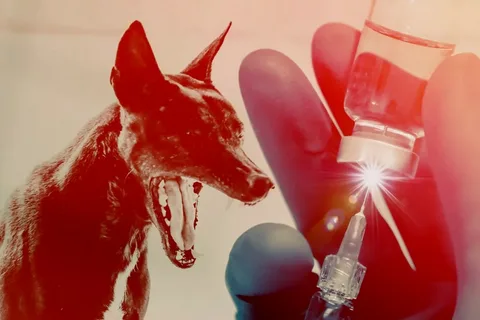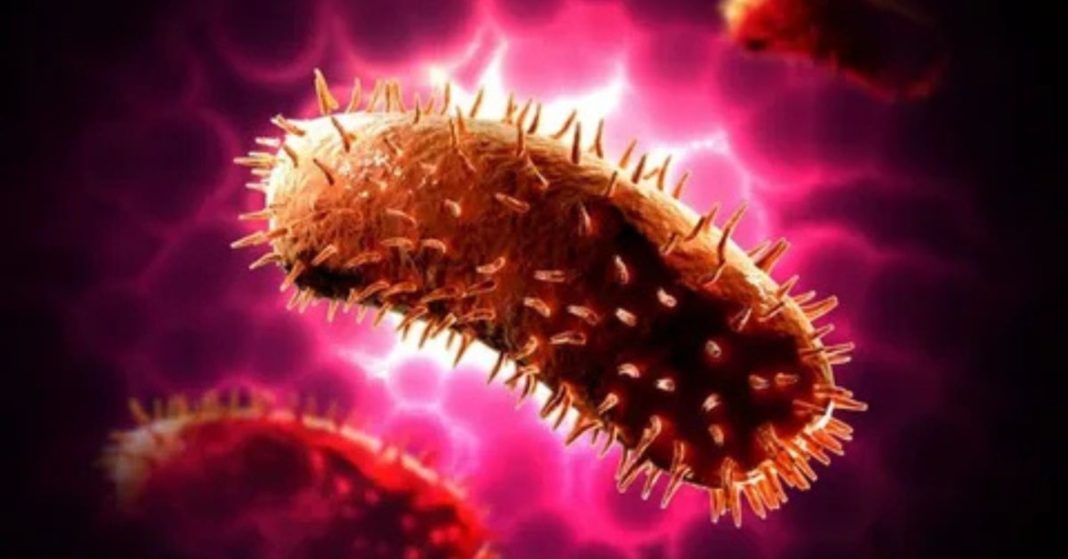Rabies is one of the most dangerous viral infections known to mankind. It silently enters the body, travels through the nerves, and causes death if not treated in time. Knowing how rabies kills is crucial for saving lives, especially in areas where animal bites are common.
What is Rabies?
Rabies is a deadly viral disease that attacks the central nervous system (CNS), which includes the brain and spinal cord. It is caused by the rabies virus, which belongs to the Lyssavirus genus. The virus mostly spreads through the saliva of infected animals, especially through bites.
More than 59,000 people die from rabies every year around the world, most of them in Asia and Africa, and a large number are children.
How Rabies Spreads in the Human Body
Understanding How Rabies Kills Starts with Its Entry Point
To understand how rabies kills, we must first learn how it gets into the human body:
- The rabies virus enters through the bite or scratch of an infected animal.
- It can also enter if infected saliva touches broken skin or mucous membranes (eyes, nose, mouth).
- Common animals that spread rabies include dogs, bats, monkeys, foxes, and raccoons.
Incubation Period: The Calm Before the Storm
After entering the body, the rabies virus remains hidden for some time. This period, known as the incubation period, can range from a few days to several months, usually between 1 and 3 months.
During this time:
- The person does not show any symptoms.
- The virus stays at the site of the wound and slowly enters nearby nerve cells.
- It then travels silently along the nerves toward the brain.
The virus avoids the blood, which is why the immune system does not detect it early.
How Rabies Kills After Reaching the Brain
How Rabies Kills by Causing Brain Inflammation
Once the virus reaches the brain, the real danger begins. Here’s how rabies kills:
- The virus multiplies rapidly inside the brain.
- It causes severe inflammation of the brain tissues (called encephalitis).
- Brain cells are damaged beyond repair.
- The virus also spreads from the brain to salivary glands, eyes, lungs, heart, and skin.
- The body starts to lose control of basic functions like breathing, swallowing, and heart rate.
- The person eventually falls into a coma and dies.
The brain damage is irreversible, which is why rabies is almost 100% fatal once symptoms start.
Detailed Stages of How Rabies Kills
Early Stage of Rabies Infection
- Fever
- Weakness or discomfort
- Headache
- Itching, tingling, or burning around the bite area
At this stage, it is still possible to prevent death through post-exposure vaccination.
Neurological Stage – How Rabies Kills Begins Here
- Anxiety and confusion
- Difficulty in swallowing (leading to hydrophobia, or fear of water)
- Hallucinations
- Muscle spasms
- Aggression or unusual behavior
- Partial paralysis
- Seizures
These symptoms mean the virus has already reached the brain. At this point, no treatment can save the patient.
Final Stage – Coma and Death
In the last stage, the patient:
- Becomes completely paralyzed
- Enters a deep coma
- May die due to respiratory failure (the brain stops sending signals to breathe)
This is how rabies kills: by shutting down the most essential parts of the brain that control life.
Why Rabies is So Dangerous
- No cure after symptoms appear
- Progresses silently and rapidly once symptoms start
- Damages the brain so severely that the body cannot survive
- One of the highest fatality rates among known diseases
Prevention is the Only Protection Against Rabies
Preventing Rabies Is the Only Way to Avoid How Rabies Kills
1. Wash the Wound Immediately
- Use soap and water
- Wash for at least 15 minutes
- This can reduce the amount of virus near the wound
2. Get Medical Help Right Away
- Visit a doctor or hospital as soon as possible
- Even small scratches must not be ignored
3. Take the Anti-Rabies Vaccine
- The vaccine must be taken in 4 to 5 doses over 28 days
- Sometimes, rabies immunoglobulin is also given if the bite is serious
4. Never Miss a Dose
- Missing even one dose of the vaccine can be fatal
- Follow your doctor’s schedule carefully

Vaccinating Animals Saves Lives
Stopping How Rabies Kills Means Controlling It in Animals
One of the most important ways to stop rabies from killing humans is by controlling rabies in animals, especially in dogs. Since more than 99% of human rabies cases are caused by dog bites, focusing on animal health is the first and strongest line of defense.
If we want to prevent how rabies kills, we must first stop it from spreading among animals. This is called “breaking the transmission chain.” Once we stop animals from carrying the virus, humans are automatically safer.
Let’s understand how animal control can help prevent this deadly disease.
1. Mass Vaccination of Dogs
- Vaccinating at least 70% of the dog population in an area can stop the spread of the rabies virus.
- This includes both pet dogs and stray (street) dogs.
- Once vaccinated, a dog will not get rabies and cannot pass it to others.
- Dog vaccination drives must be done regularly every year.
2. Sterilization and Population Control
- In many cities and villages, the number of stray dogs is increasing.
- Through Animal Birth Control (ABC) programs, stray dogs can be sterilized (made unable to reproduce).
- This keeps the dog population under control and makes mass vaccination easier.
- Fewer unvaccinated dogs means less risk of rabies.
3. Responsible Pet Ownership
- Pet owners must get their dogs and cats vaccinated against rabies once a year.
- They must not let pets roam freely on the streets, where they can get infected or bite others.
- Injured or sick animals must be taken to a veterinary doctor immediately.
4. Avoiding Contact with Wild Animals
- Wild animals like bats, foxes, and raccoons can carry rabies in some regions.
- People should not try to feed, pet, or catch wild animals.
- If a wild animal behaves strangely (too friendly, aggressive, or not afraid of people), stay away and inform local animal control or forest officers.
5. Community Awareness and Reporting
- People must be taught that even a small scratch from a dog or cat can cause rabies.
- Communities should report any dog bite cases, unusual animal behavior, or dead animals to health or veterinary departments.
- Children should be educated in schools about what to do after an animal bite.
6. Government and NGO Involvement
- Local health departments, municipalities, and NGOs must work together to:
- Conduct free vaccination camps
- Run street dog sterilization programs
- Raise awareness in communities
- Supply anti-rabies vaccines in government hospitals
Why This Matters
If rabies is controlled in animals, especially dogs, we can completely stop human rabies deaths. This method has already worked in several countries like:
- Sri Lanka, where dog vaccination and sterilization helped reduce rabies cases drastically.
- Thailand and Mexico, where school programs and dog control nearly eliminated human rabies.
- Bhutan, where mobile vet teams regularly vaccinate dogs in villages and towns.
So, stopping how rabies kills begins with animals, not humans. By protecting animals, we protect ourselves.
Final Thought
To fight rabies effectively, humans and animals must both be safe. When we vaccinate animals, control their numbers humanely, and avoid dangerous contact, we create a barrier that the rabies virus cannot cross. That is how we truly stop rabies from killing — by acting early, starting with the animals that carry it.
Real-Life Example: A Preventable Tragedy
A 10-year-old child in rural India was bitten by a stray dog. The family ignored the bite thinking it was minor. Weeks later, the child began to fear water and became very aggressive. He was taken to the hospital too late. The doctors could not save him. This is a heartbreaking example of how rabies kills due to lack of awareness and late treatment.
Conclusion: Understand How Rabies Kills to Save Lives
Rabies is a terrifying disease, not because it spreads fast, but because it kills with certainty once symptoms begin. Learning how rabies kills helps us understand the importance of quick action, vaccination, and awareness. Rabies deaths are completely preventable, but only if we act in time. Don’t wait for symptoms to appear — because by then, it’s often too late.
Frequently Asked Questions (FAQ)
Q1. What is rabies?
Rabies is a deadly virus that attacks the brain and spinal cord. It spreads through the bite or scratch of an infected animal, mostly dogs.
Q2. How does rabies kill a person?
Rabies kills by slowly traveling through the nerves to the brain. Once it reaches the brain, it causes swelling, damage, and failure of basic life functions like breathing and heart control. Without early treatment, it almost always leads to death.
Q3. How long does it take for rabies to kill after a bite?
Rabies can take a few days to several months to show symptoms. This is called the incubation period. Once symptoms start, the disease usually leads to death within a few days.
Q4. Is there any cure once symptoms of rabies appear?
Unfortunately, no. Once symptoms begin, there is no cure for rabies. That’s why it’s important to start treatment immediately after a bite or scratch.
Q5. How can we prevent rabies after a dog bite?
Wash the wound with soap and water for at least 15 minutes. Then go to a doctor quickly to get anti-rabies injections. Completing the full vaccine schedule is very important to prevent rabies.
Q6. Can a person survive rabies?
Only a very few people have survived rabies after symptoms appeared, and those are extremely rare cases. Most people survive only if they get vaccinated before symptoms start.
Q7. Which animals can spread rabies?
Dogs are the most common source of rabies in humans, especially in India and Africa. Other animals that may spread rabies include bats, monkeys, foxes, raccoons, and cats.
Q8. What are the symptoms of rabies?
Early symptoms are like flu — fever, headache, and tiredness. Later symptoms include fear of water (hydrophobia), confusion, anger, muscle spasms, and eventually coma and death.
Q9. What should I do if my pet bites someone?
You should:
- Wash the wound on the person
- Take them to a doctor immediately
- Make sure your pet is vaccinated
- Observe the pet for any unusual behavior
Q10. Can children get rabies?
Yes, children are more at risk because they often play with animals and may not report small bites or scratches. Parents should teach children to avoid stray animals and report all bites.




